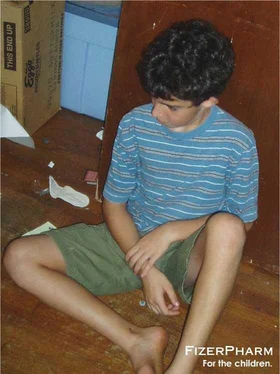
This is Donnie Maass, a nine-year-old high-functioning autistic savante from New York; very limited social skills, but he could calculate six-digit prime numbers in his head. If you recognize the name, you’ll know that this picture was taken before he was subjected to experimental therapy in which a tweaked retrovirus rewrote certain critical genes linked to his condition. Basically, we hoped to cure his autism by rewriting his code at the molecular level.

This is Donnie Maass eight weeks after the onset of gene therapy. This discoloration is not anemia; Donnie’s blood volume had actually increased by seven percent—but he had begun to redistribute the blood volume away from the peripheral tissues and sequester it deep in the core, for reasons that were (at that time) unknown. And while this bloodless complexion is Donnie’s most obvious physical symptom, there were others, including

marked recession of the gum-line, and increased reflectivity of the retina, reminiscent of the tapetum lucidum found in the eyes of cats and other nocturnal predators. We also noticed behavioral changes—Donnie exhibited increased activity levels during nighttime and began sleeping during the day, and during sleep his metabolic rate fell to about half of what it should have been.
Perhaps most disturbingly, psychological testing revealed an increasing lack of affect and reduced responses to emotionally- charged stimuli. When shown photos of people mutilated during car accidents or Homeland Security interviews, for example, Donnie’s skin conductivity and ECG were scarcely different from when he was shown neutral pictures such as landscapes or still- lifes. (We would have liked to pursue this aspect further, and had in fact arranged for a series of MRIs, but Donnie’s parents withdrew permission after one of our technicians accidentally left the slideshow running during visiting hours):

Suffice to say, based on the data we did collect, Donnie was developing the behavioural symptoms of a clinical psychopath; he was scoring progressively higher on the Hare Psychopathy checklist, and his empathy quotient—which was pretty low to begin with—began dropping even further.

At around the same time his performance on general patternmatching and logic tests began increasing, and his numerical hyperperformance—which had always been limited to the calculation of primes—began manifesting in other areas as well. Donnie was suddenly able to perform calendar tricks, and he developed a real facility for calculus. Unfortunately we were never able to assess the ultimate extent of his abilities, since around the eleven-week mark he grew increasingly uncooperative with our research staff, and at times became quite violent.

This is a picture of Donnie taken just prior to autopsy, sixteen weeks after the onset of therapy. The gumline recession has become unmistakably pronounced, as has the skin pallor (although the fact that Donnie is dead may be a factor here as well). The rictus reflects Donnie’s condition at death; in fact, he died following the onset of sudden violent convulsions which strongly resembled grand mal seizures. Like epilepsy, these seizures appear to have been provoked by some critical visual stimulus — but he wasn’t watching any flashing or strobing lights when the convulsions began. He was viewing a multimedia display we’d used for psychological testing many times before, without any problems. Looking back, he had grown increasingly reluctant to use the display in the days prior to his complications; this might have suggested some kind of aversion building over time. Back then, of course, we reasonably assumed that this was part and parcel of his increasing overall belligerence, and there was no reason to expect that strapping him down, pinning his eyes open and forcing him to watch the display would have had such dramatic results. Hindsight, as they say, is 20/20.

At any rate, this is the multimedia panel that provoked Donnie’s difficulties. And as it turns out, it wasn’t so much the pictures themselves as the shape of the borders between them that was the problem.
Now it’s important not to lose sight of the fact that, while these side effects did ultimately prove problematic, the therapy did in fact cure Donnie’s autism. It would therefore be needlessly pessimistic to describe our preliminary work as a “failure”, especially since even the side-effects themselves, while admittedly fatal to the patient, did result in some profoundly important findings I’ll be sharing with you today.

Autopsy revealled a number of significant findings at both gross and microscopic levels. Capilliary beds had formed in the body core—now we all have these, the digestive system is highly vascularised to facilitate nutrient transport from the intestine into the bloodstream, but the capillary meshes in Donnie’s core were far more extensive than anything we’d seen before.
Tissue levels of adenosine triphosphate were elevated; ATP is the chemical battery that powers the cell, and this explains the abnormal strength and stamina that Donnie displayed during his final days.
Blood work turned up high concentrations of Leuenkephalin, an opioid peptide found in animals like bears and squirrels, and is involved in hibernation.
Donnie’s immune system also showed unusual resistance to prionic diseases like Creuzfeld-Jakob. Such resistance is usually found only in cannibalistic cultures; cannibals are a high-risk group when it comes to prions.
Donnie’s amygdala and his visual cortex — essentially, the patternmatching wetware at the back of the head—were 7 and 13% larger than they should have been, respectively. Synaptic interconnections between the anterior cingulate gyrus and the rest of the brain were much lower than normal, almost as if the core of the brain were being isolated from the neocortex 
We also discovered some very unusual wiring in the retina. Some of you may know that our eyes contain whole arrays of specialized receptor cells; some fire only when they see light and shadow in conjunction, some fire only when they see horizontal lines—horizons and so on. In Donnie’s case, the receptors that respond to horizontal lines had somehow become crosswired with those that respond to vertical ones. When both sets of receptors fired simultaneously in a very specific way—that is, when intersecting right angles occupied more than thirty degrees of visual arc—positive feedback generated a neuroelectrical overload in the visual cortex. This was what had caused Donnie’s adverse reaction to this cross imagery on the display.
Читать дальше




















![Питер Уоттс - Водоворот. Запальник. Малак [litres]](/books/420290/piter-uotts-vodovorot-zapalnik-malak-litres-thumb.webp)